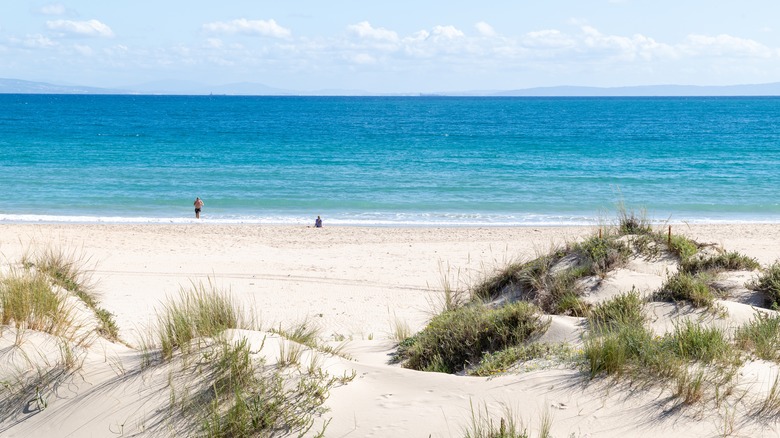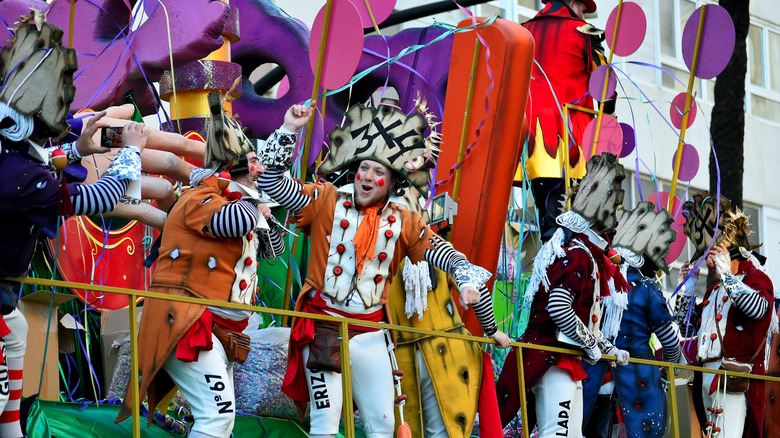Spain's 'Little Havana' Is A Secret Paradise With Unspoiled Beaches And Caribbean Carnival Spirit
On Spain's southern coast, the sun shines brightly for more than 300 days a year. A lengthy beachfront promenade with vibrant historical buildings serving as a colorful backdrop make travelers do a double take when visiting Cádiz. The capital city of the province of Cádiz, the city's striking resemblance to the Cuban capital has earned it the moniker of Spain's "Little Havana."
From sprawling white sand beaches, festivities, and celebrations that rival a Caribbean carnival, to an accent that sounds similar to their Cuban counterparts, these elements blend enough similarities to Cuban culture to make you forget where you actually are. An ancient port city in Andalucía (or sometimes Andalusia), Cádiz is the oldest city in Western Europe (and the oldest city in Spain that's a pure, coastal paradise). Its southernmost location made it quite appealing to many cultures, with Romans, Greeks, Phoenicians, and Arabs all spending time there.
To get to Cádiz, you will need a car to explore the city, surrounding beaches, and neighboring towns. Spain is one of the best countries for road trips and its an easy drive from another vibrant, must-visit Spanish city like Sevilla (a little over an hour away). While the closest airport is the Jerez Airport, which is 30 minutes away by car, the Sevilla Airport (SVQ) is bigger and likely has more international flight options (also a little over an hour away).
Exploring the beaches and beyond
Any Spaniard will tell you to head south for sun and beaches, with Cádiz topping the list for vacations. Beaches run the length of the Costa de Luz, from Chiclana to San Roque. In Cádiz proper, there are a handful of urban city beaches around the city center. Santa María del Mar is located below the promenade, and Playa de la Cortadura is located along Highway 33 just outside the city center. While the beach is nice, parking is tough. For the best beaches in the region, however, you need to head down the coast, outside the city but still within the province of Cádiz.
Bolonia Beach is a white sand beach, also known for an impressive dune that was actually made into a Natural Monument. Make sure you climb to the top as the views are worth the trek. Nearby is the ancient Roman city of Baelo Claudia, where you can see the remnants of Roman salting factories that were used to salt locally-caught tuna before shipping it out across the Roman Empire. For DJ vibes on the beach, head to La Barrosa in Chiclana, or for something more mellow head to La Loma del Puerco or Novo Sancti Petri. The almost nine mile stretch between Conil de la Frontera and Vejer de la Frontera features several options for a laidback beach day, despite how crowded it is since the beaches are quite big.
Beyond the city of Cádiz, the province is also home to many other charming towns that you can check out on a road trip through the area. Jerez de la Frontera, Vejer de la Frontera, and Sanlúcar de Barrameda are each known for unique characteristics like their whitewashed, hilltop buildings, or unique seafood dishes.
Music and Carnival in Cádiz
The music scene in Cádiz isn't that different from the one in Havana. Both cities have a deep appreciation for music and culture, and while music in Cádiz is rooted more in flamenco than Cuban jazz, it was heavily influenced by Cuban music. In fact, many musicians from Cádiz have traveled to Havana to learn the musical masters. This cross-cultural exchange is reflected in the warm, joyful music that has Caribbean notes. To see a flamenco show, try La Cava, a traditional flamenco tavern, or Peña Flamenco La Perla de Cádiz.
Carnival in Cádiz typically takes place in February. A combination of parades, street performances, competitions, costumes, and music make it a lively affair. A massive street fair that lasts 11 days, Carnival is one of the most highly anticipated celebrations, drawing thousands of visitors each year. Preparations often take a whole year and any plans to visit should also be booked just as far in advance (if not more). Rehearsals for the Falla Theatre competition begin in earnest a month in advance and musical groups called chirigotas begin singing their humorous songs on the street, often critiquing current affairs from the year.
The Grand Finale is held on the first Friday of Carnival and lasts until the next day. Costumes are a must when attending Carnival, as are the two main parades. On the first Sunday of Carnival, The Gran Cabalgata (Great Parade) takes place with thousands of people in attendance. On the last weekend of Carnival, the Cabalgata del Humor (Comedy Parade) takes place in the Old Town of the city. Overall, the entire festival is an explosion of fireworks, impromptu singing performances, dancing, and all around revelry for people of all ages.


